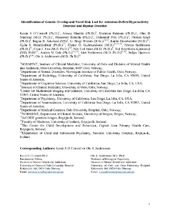Identification of genetic overlap and novel risk loci for attention-deficit/hyperactivity disorder and bipolar disorder
O`Connell, Kevin; Shadrin, Alexey A.; Bahrami, Shahram; Smeland, Olav Bjerkehagen; Bettella, Francesco; Frei, Oleksandr; Krull, Florian; Askeland, Ragna Bugge; Walters, Bragi; Davíðsdóttir, Katrín; Haraldsdóttir, Gyða; Guðmundsson, Ólafur; Stefánsson, Hreinn; Fan, Chun C.; Steen, Nils Eiel; Reichborn-Kjennerud, Ted; Dale, Anders; Stefánsson, Kári; Djurovic, Srdjan; Andreassen, Ole Andreas
Peer reviewed, Journal article
Accepted version
Permanent lenke
https://hdl.handle.net/1956/23296Utgivelsesdato
2019Metadata
Vis full innførselSamlinger
Originalversjon
https://doi.org/10.1038/s41380-019-0613-zSammendrag
Differential diagnosis between childhood onset attention-deficit/hyperactivity disorder (ADHD) and bipolar disorder (BD) remains a challenge, mainly due to overlapping symptoms and high rates of comorbidity. Despite this, genetic correlation reported for these disorders is low and non-significant. Here we aimed to better characterize the genetic architecture of these disorders utilizing recent large genome-wide association studies (GWAS). We analyzed independent GWAS summary statistics for ADHD (19,099 cases and 34,194 controls) and BD (20,352 cases and 31,358 controls) applying the conditional/conjunctional false discovery rate (condFDR/conjFDR) statistical framework that increases the power to detect novel phenotype-specific and shared loci by leveraging the combined power of two GWAS. We observed cross-trait polygenic enrichment for ADHD conditioned on associations with BD, and vice versa. Leveraging this enrichment, we identified 19 novel ADHD risk loci and 40 novel BD risk loci at condFDR <0.05. Further, we identified five loci jointly associated with ADHD and BD (conjFDR < 0.05). Interestingly, these five loci show concordant directions of effect for ADHD and BD. These results highlight a shared underlying genetic risk for ADHD and BD which may help to explain the high comorbidity rates and difficulties in differentiating between ADHD and BD in the clinic. Improving our understanding of the underlying genetic architecture of these disorders may aid in the development of novel stratification tools to help reduce these diagnostic difficulties.
